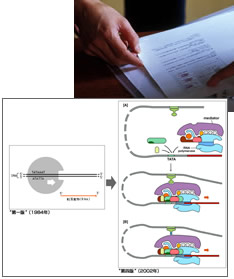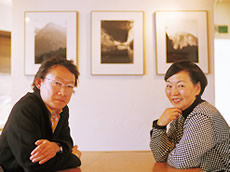| Biohistory journal,Summer, 2005: Index >Using observation for hand-drawn illustrations and photography that seeks rediscovery |
| Reproduction and sharingy Using observation for hand-drawn illustrations and photography that seeks rediscovery Chihiro Minato and Keiko Nakamura | |
| |
A comparison of the diagrams in “The Transfer from DNA to RNA”, versions that are roughly 20 years apart, shows that the one on the right is very detailed with many elements elucidated. One understands the essence, however, from the one on the left. Minato: I see. That’s interesting (Laughs). Just looking at them quickly with no explanation, I like the one on the left. It has more beauty. Nakamura: I didn’t expect the judgment that it was beautiful, but I understand it. Actually, when I read it, I thought the previous edition was exciting. I think there is beauty and excitement in science that transcends mere understanding. Minato: Though beautiful pictures existed during the period of natural history, one no longer drew things one saw by hand after photography was invented. Observation disappeared. We must consider the observation of these times. |
I rediscovered the importance of images in science when I was shown the diagrams of molecular biology. The term “grip” is used to mean “understand” both in Japanese and English. Eye and hand functions are important, but today, when the use of simulations flourishing, it may be difficult, realistically speaking, to recover the time for observation, depicting the scenes of science in the field once again using one’s own body. If efficiency and competition alone are given precedence, the time for observation will disappear. The most fundamental approach of art towards nature is taking the time to observe something while having true affection for the subject. If perhaps the cooperation of sorts that art and science once had were to be reconstructed, it might lead to an understanding of life. |
| Dialogue |
|
Please close a window with the button of a browser who are turning off Javascript. |

